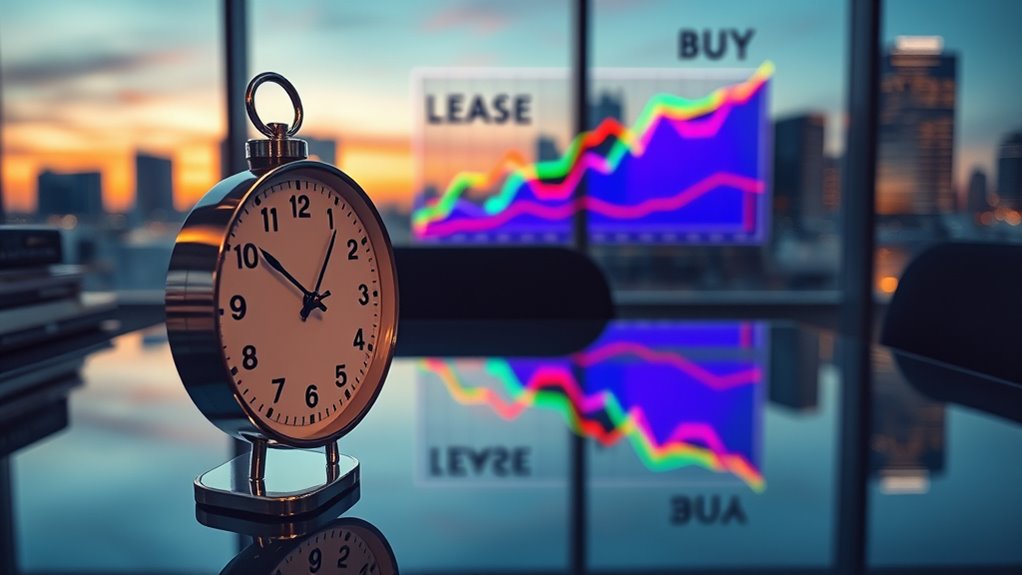When interest rates rise, your cost of financing increases, making buying more expensive and leasing more attractive due to fixed monthly payments and easier tax deductions. Higher rates also reduce the benefits of depreciation, affecting your tax savings. This shift may favor leasing for better cash flow management and lower upfront costs. To understand how these rate changes impact your decision and explore strategies, keep going to discover more insights.
Key Takeaways
- Rising interest rates increase borrowing costs, making buying less attractive and leasing more appealing due to predictable expenses.
- Higher financing costs diminish the tax benefits of depreciation, potentially favoring leasing in a high-rate environment.
- Leasing offers fixed payments and lower upfront costs, providing better cash flow management amid fluctuating interest rates.
- When interest rates are low, buying can be advantageous for long-term asset ownership and building equity.
- Elevated rates make financing more expensive, shifting the balance toward leasing as a more cost-effective and flexible option.

Are rising interest rates making you reconsider whether to lease or buy? As borrowing costs increase, your decision becomes more complex, and understanding the financial implications is key. One major factor is how interest rates influence the overall cost of financing a purchase. When rates climb, the expense of taking out a loan to buy equipment or property rises, which can make leasing seem more appealing. But don’t forget about the tax implications—these can profoundly sway your decision. Leasing often offers straightforward monthly payments that may be easier to deduct from your taxes, while owning involves capitalizing the asset and depreciating it over time. Asset depreciation becomes a vital point here; it determines how quickly you can recover the asset’s value for tax purposes. When you buy, you typically depreciate the asset over its useful life, which can help lower your taxable income annually. However, higher interest rates can limit your ability to benefit from depreciation strategies, especially if the purchase involves financing that’s more expensive or less favorable.
Additionally, the use of affiliate links to finance or acquire assets can influence the total cost and decision-making process, especially as interest rates fluctuate.
On the other hand, leasing might seem more flexible and less risky in a rising rate environment. Since lease payments are generally fixed and predictable, you avoid the upfront costs and fluctuating interest expenses tied to a purchase. This predictability can help with cash flow management, particularly if interest rates are volatile. Additionally, leasing often requires less initial capital, meaning you won’t need a large down payment or to tie up capital in an asset that might depreciate quickly. But remember, lease payments are usually fully deductible as operating expenses, which can be advantageous if you’re looking to maximize tax deductions annually without worrying about asset depreciation schedules or salvage value.
However, if you plan to hold onto an asset long-term, buying might still be the better option despite rising interest rates. When you own, you gain the benefit of the asset’s depreciation, which can offset income and reduce tax liability. Plus, once the loan is paid off, you no longer have monthly payments, and the asset’s value might appreciate or be fully recovered through resale. Still, rising interest rates make financing more costly, directly impacting your bottom line and potentially negating some of the tax advantages of ownership. Ultimately, your choice hinges on your financial situation, cash flow needs, and how you weigh tax benefits against financing costs. Both options have their merits, but understanding how interest rates influence these variables helps you make a more informed, strategic decision.
Frequently Asked Questions
How Do Interest Rate Changes Impact Lease Negotiations?
Interest rate changes directly impact your lease negotiations by influencing the lease term and your overall costs. When interest rates rise, you might face higher monthly payments and prefer shorter lease terms to reduce interest exposure. A good credit score can help you secure better interest rates, lowering your costs. Conversely, lower rates make longer lease terms more attractive, giving you flexibility and potential savings during periods of favorable interest rate conditions.
What Are the Long-Term Effects of Rising Interest Rates on Leasing?
Did you know that rising interest rates can increase lease costs by up to 15% over time? When rates climb, you should carefully consider lease term considerations, as longer leases may lock you into higher payments. Additionally, persistent rate hikes can impact your credit, making future financing more expensive. So, plan ahead to mitigate these effects, and always weigh leasing options against buying in a fluctuating interest rate environment.
How Do Fluctuating Interest Rates Influence Buyout Options?
Interest rate fluctuations directly affect your buyout options through interest rate sensitivity and buyout valuation. When rates rise, the buyout valuation tends to decrease, making it less attractive to purchase outright due to higher financing costs. Conversely, falling rates boost valuation and reduce interest expenses, encouraging buyouts. Stay aware of market trends, as these shifts influence your decision-making, impacting the overall cost and feasibility of executing buyout options.
Are Lease Rates Affected by Central Bank Interest Rate Policies?
Did you know that lease rate trends often move inversely to central bank policies? When central banks hike interest rates, lease rates typically increase as the cost of financing rises. Conversely, easing policies can lower lease rates, making leasing more attractive. So, you should monitor central bank actions closely, because their policies directly influence lease terms and affordability, affecting your leasing decisions and overall business strategy.
How Can Businesses Hedge Against Interest Rate Volatility in Leasing?
To hedge against interest rate volatility in leasing, you should consider using interest rate derivatives like swaps or options, which can lock in rates or provide protection if rates rise. Additionally, employing inflation hedging strategies helps safeguard your leasing costs from inflation-related increases. These tools enable you to manage financial risks proactively, ensuring more predictable expenses, regardless of fluctuations in interest rates or inflation.
Conclusion
Just like a pendulum swings back and forth, interest rates can tip the scales between leasing and buying. When rates rise, leasing often becomes more attractive, while lower rates make buying more appealing. Keep an eye on these swings, as they directly influence your decision. By understanding how interest rates pulse through the market, you can better position yourself to make the most informed choice—like catching the perfect wave at just the right moment.










